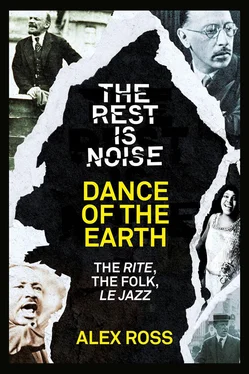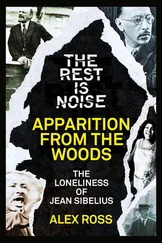The oldest of the chief innovators of early-twentieth-century music, Janáček was almost fifty when he finished his first masterpiece, the opera Jenůfa, in 1903. Like Pelléas and Salome, written in the same period, Jenůfa, is a direct setting of a prose text. The melodies not only imitate the rise and fall of conversational speech but also illustrate the characteristics of each personality in the drama. For example, there is a marked musical distinction between Jenůfa, a village girl of pure and somewhat foolish innocence who has a baby out of wedlock with the local rake, and the Kostelnička (sextoness), her devout stepmother, who eventually murders the baby in an effort to preserve the family reputation. In the opening scene of Act II, the Kostelnička sings in abrupt, acerbic phrases, sometimes leaping over large intervals and sometimes jabbing away at a single note. Jenůfa’s melodies, by contrast, follow more easygoing, ingratiating contours. Behind the individual characterizations are pinwheeling patterns that mimic the turning of the local mill wheel, the meticulous operation of social codes, or the grinding of fate. The harmonies often have a disconcerting brightness, all flashing treble and rumbling bass. The coexistence of expressive freedom and notated rigidity in the playing suggests rural life in all its complexity.
Jenůfa seems destined to end in tragedy. The heroine’s baby is found beneath the ice of the local river; the villagers advance on her with vengeful intent. Then the Kostelnička confesses that she did the deed, and they redirect their rage. Jenůfa is left alone with her cousin Laca, who has loved her silently while she has pursued the good-for-nothing Števa. Time stops for a luxurious instant: the orchestra wallows in elemental C major. Then, over pulsing, heavy-breathing chords, violins and soprano begin to sing a new melody in the vicinity of B-flat—a sustained note followed by a quickly shaking figure, which moves like a bird in flight, gliding, beating its wings, dipping down, and soaring again. This is Jenůfa’s loving resignation as she gives Laca permission to walk away from the ugliness surrounding her. Another theme surfaces, this one coursing down the octave. It is Laca answering: “I would bear far more than that for you. What does the world matter, when we have each other?” The two sing each other’s melodies in turn, the melodies merge, and the opera ends in a tonal sunburst.
Janáček, like Mahler, talked about listening to the chords of nature. While working on his cantata Amarus, he wrote: “Innumerable notes ring in my ears, in every octave; they have voices like small, faint telegraph bells.” These natural sounds are linked to the opera’s tough-natured emotional world, the hard-won love of a man and a woman in the wake of a terrible crime. No wonder audiences in Vienna and other European capitals were struck by Jenůfa when it finally made its way past Czech borders in the year 1918. Following the devastation of war, Janáček had unleashed the shock of hope.
Bartók’s father, like Janáček’s, was a teacher who worked with the rural population, running an agricultural school that aimed to introduce modern farming methods to the Hungarian countryside. He died young, and Bartók’s mother supported the family by giving piano lessons in towns around Hungary. A shy and sickly child, Béla took refuge in music even before he could speak. By the age of four, apparently, he could play forty folk songs with one finger at the piano.
In 1899, at the age of eighteen, Bartók moved to Budapest to study at the Royal Academy of Music. He made his mark first as a pianist of fierce technique and fine expression; his early compositions emulated Liszt, Brahms, and Strauss, whose Ein Heldenleben he transcribed for the piano. But his musical priorities shifted when he read the stories of Maxim Gorky, in which peasants, long scorned or prettified in literature, become flesh-and-blood people. With another gifted young Hungarian composer, Zoltán Kodály, Bartók set about inventing a new brand of folk-based musical realism.
At first, the young Hungarians followed the established formula, collecting folk melodies and concocting handsome accompaniments for them, as if putting them in display cases. Then, after several expeditions into the countryside, Bartók acknowledged the gap between what urban listeners considered folkish—a professional Gypsy band playing a csárdás dance, for example—and what peasants were actually singing and playing. He decided that he had to get as far as possible from what he would later call the “destructive urban influence.”
In his manipulation of folk material, Bartók went rather further than Janáček, who found authenticity in city and country settings alike. There was a certain fanaticism inherent in Bartók’s philosophy; as the scholar Julie Brown observes, his diagnosis of the contaminating influence of cosmopolitan culture was only a step or two away from the noxious racial theorizing that was à la mode in Bayreuth. What saved Bartók from bigotry was his refusal to locate his musical truths in any one place; he heard them equally in Hungary, Slovakia, Romania, Bulgaria, Serbia, Croatia, Turkey, and North Africa. The mark of authenticity was not racial but economic; he paid heed mainly to the people on the social margins, those who had lived the toughest lives.
Bartók’s most intense encounter with the Folk took place in 1907, when he went to the Eastern Carpathian Mountains, in Transylvania, to gather songs from Hungarian-speaking Székely villagers. Personal upheaval added urgency to the mission; the composer had fallen in love with a nineteen-year-old violinist named Stefi Geyer, who received his advances first with bemusement and then with alarm. Both the letters he wrote to Geyer that summer and his meticulous notes on Transylvanian songs give the impression that a fenced-off soul is opening itself to the chaos of the outer world.
Like Grainger in England, Bartók brought with him an Edison cylinder, and he listened as the machine listened. He observed the flexible tempo of sung phrases, how they would accelerate in ornamental passages and taper off at the end. He saw how phrases were seldom symmetrical in shape, how a beat or two might be added or subtracted. He savored “bent” notes—shadings above or below the given note—and “wrong” notes that added flavor and bite. He understood how decorative figures could evolve into fresh themes, how common rhythms tied disparate themes together, how songs moved in circles instead of going from point A to point B. Yet he also realized that folk musicians could play in absolutely strict tempo when the occasion demanded it. He came to understand rural music as a kind of archaic avant-garde, through which he could defy all banality and convention.
Emotional rejection can have a radicalizing effect, as Schoenberg’s history in 1907 and 1908 suggests. Bartók, pining for the unavailable Stefi, swung away from Romantic tonality in those same two years. The Violin Concerto No. 1, his main work of this period, shows him still in thrall to a Richard Strauss aesthetic, with a five-note theme representing his beloved at the head of the piece. He planned but did not compose a third movement, which would have shown the “hateful” side of the unfortunate girl. Some of that negative energy spills out in the Fourteen Bagatelles for piano, written in the spring of 1908. A kind of substitution of love objects occurs: in place of Stefi’s leitmotif there are now rusty shards of folk melody, showing the impact of the Transylvanian trip and other research expeditions. The Woman becomes the Folk.
The first Bagatelle begins with a radical harmonic break: the right hand plays roughly in C-sharp minor while the left plays in something like the key of C (in the Phrygian mode). This is “polytonality” or “polymodality,” the juxtaposition of two or more key-areas, and it will play a significant role in early-and mid-twentieth-century music. Bartók probably derived the practice from Strauss and Debussy, but he also liked to attribute it to folk players, who periodically wandered free from their accompanying harmonies.
Читать дальше












